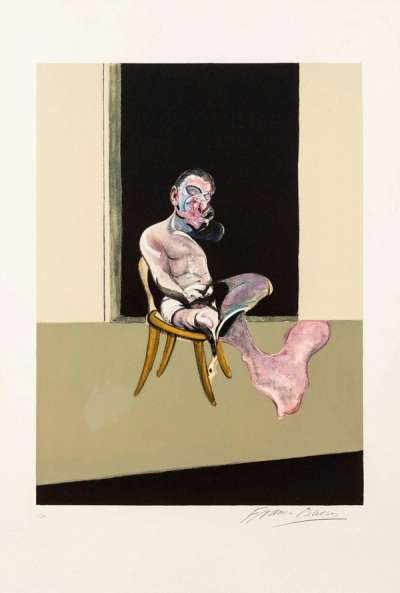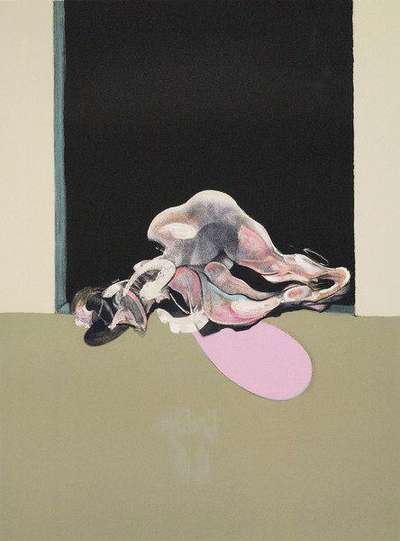
Triptych August 1972 (left panel)

Triptych August 1972 (left panel)
Signed Print
Francis Bacon
Price data unavailable
AAGR (5 years) This estimate blends recent public auction records with our own private sale data and network demand.
There aren't enough data points on this work for a comprehensive result. Please speak to a specialist by making an enquiry.
Medium: Lithograph
Edition size: 180
Year: 1972
Size: H 61cm x W 49cm
Signed: Yes
Format: Signed Print
TradingFloor
Track this artwork in realtime
Watch artwork, manage valuations, track your portfolio and return against your collection
Track auction value trend
Auction Results
| Auction Date | Auction House | Location | Hammer Price | Return to Seller | Buyer Paid |
|---|---|---|---|---|---|
| October 2021 | Artcurial | France | |||
| June 2018 | Chiswick Auctions | United Kingdom | |||
| June 2017 | Phillips London | United Kingdom | |||
| July 1994 | Christie's London | United Kingdom |
Meaning & Analysis
Haunting and mournful, Francis Bacon's Triptych August 1972 is one of the artist's most harrowing works from his so-called 'Black Triptychs'. Created after the suicide of his lover and long-term companion, George Dyer, Triptych August 1972 (left panel) is testament to Bacon's consuming grief. Sat on a simple wooden chair is Dyer's figure, studied posthumously, with his form rendered in a ghostly mix of fleshy pink and blue. Dyer's distorted face gazes over to the right of the composition, leading the viewer's eye across Triptych August 1972 (centre panel) towards Bacon's self-portrait in Triptych August 1972 (right panel). Like so many of Bacon's figurative studies, Dyer's figure sits in a poignantly empty scene. The grey painted floor, punctuated by a black band at the bottom of the work, creates a powerful compositional line that unites the three panels together. Behind Dyer's disturbing figure, a rectangular black void stretches up the composition, appearing to recess into the background like a doorway to death.
Created in the year following the death of George Dyer, Triptych August 1972 is an homage to Bacon's longing and regret for the loss of his lover and companion. Triptych August 1972 (left panel) pictures Dyer, Bacon's longstanding muse, fading away into a pitiable nothingness. Bacon met Dyer at the end of 1963 in one of Soho's pubs, and the pair's lives became instantly intertwined. Born into a family of organised crime and debauchery, Dyer was a troubled gang-associated man who, unsurprisingly, piqued the interest of Bacon's psychologically penetrative imagination. Throughout their tumultuous relationship, Bacon painted Dyer numerous times, but Triptych August 1972 (left panel) betrays Bacon's grief after Dyer's untimely death. Just one day before Bacon's solo show at Paris' Grand Palais in October 1971, Dyer's body was discovered slumped over the toilet of his hotel suite.
Unlike Bacon's solid form in Triptych August 1972 (right panel), Dyer's torso seems to fade to black, disappearing into the foreboding void behind him. To the left of his figure, a fleshy pool cascades down the legs of the chair, almost like a shadow composed of his corpse. The work is revealing of Bacon's animalistic handling of the human body, leaving little room for spirituality to convey the gruesome reality of death. In the right panel of the triptych, a similar fleshy shadow is attached to Bacon's figure, perhaps signalling the lingering pain of the love which tied the pair together beyond death. Dyer's eyelids appear sealed shut with his head turned towards the centre and right panels, almost like a quiet resignation to his fate. As lover, companion, and muse, Dyer's life was marred by constant expectation which, despite his unrelenting devotion to Bacon, eventually led him to the ever-present shadow of death this work represents. Much like its companion panels, Triptych August 1972 (left panel) is thus one of Bacon's most psychologically poignant and immersive works, relaying the artist's loss, grief, and guilt during this cataclysmic year of his life.

